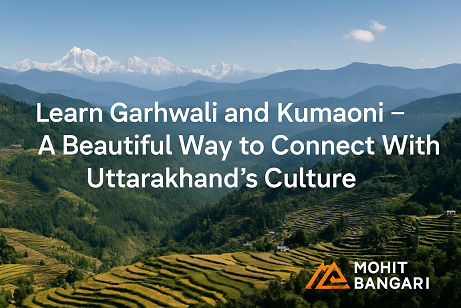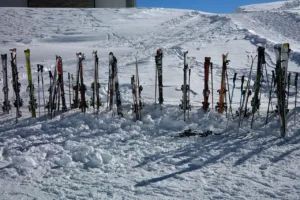By – Mohit Bangari

Explore Himalaya With Me!!

Uttarakhand is famous for its Devbhoomi identity, Himalayas, Char Dham, rivers and culture. But one thing slowly getting lost is our local languages. From Pahari dialects to tribal tongues, many languages are at the edge of extinction. If we don’t protect them now, we may lose them in the next 10 years. With them, we will lose many old stories, traditional wisdom, folk songs and identity.
Uttarakhand has many spoken languages. But due to lack of recognition and changing lifestyle, several are becoming endangered. Let’s look at them:
Spoken by the Jad Bhotia tribe in villages like Nelang, Jadhang (Uttarkashi).
Very few speakers now, mostly elderly.
Language is related to Tibetan and has no script.
Youth are shifting to Hindi or Garhwali.
Spoken in Niti and Mana valleys of Chamoli.
Closely linked to Tibetan and old Buddhist texts.
Tolcha dialect of Rongpo is already extinct.
Schools don’t teach this language anymore.
Spoken in Darma Valley near Dharchula (Pithoragarh).
Tribe mainly lives near Indo-Nepal border.
Less than 2,000 speakers remain.
No books, no recognition, and almost no efforts for preservation.
Native to Byans valley, also near Pithoragarh.
Belongs to West Himalayish group of languages.
Only around 500–600 speakers are left.
Young people use Hindi or Nepali more now.
Spoken in Chaudans valley, close to Nepal border.
Tribal communities like Rung use this.
One of the most endangered – fewer than 800 speakers.
No written script, no online resources.
Even though Garhwali and Kumaoni are spoken by lakhs of people, they are still considered vulnerable.
These languages are not taught in schools.
Younger generation understands, but does not speak.
People feel ashamed to speak their own language in public.
There is no recognition under the Eighth Schedule of Indian Constitution.
If this continues, in the next 20–30 years, even these might become endangered.
There are many reasons behind the decline:
Education and government jobs need Hindi or English, not local languages.
No proper textbooks, dictionaries, or teaching materials.
Many families stop speaking in local language at home.
Migration to cities is disconnecting youth from native tongue.
No official recognition or government support till now.
Yes, we can – but only with serious efforts. These are our cultural treasures, and saving them is not just about speaking; it’s about saving our identity.
Include Garhwali, Kumaoni, and tribal languages in school syllabus, especially in remote areas.
YouTube videos, reels, folk songs, and storytelling in local language can connect youth.
Record elders speaking, singing and telling stories. Make it available online and in schools.
Garhwali and Kumaoni should be added to Eighth Schedule. Local dialects should be part of culture policies.
Villagers, teachers, parents and panchayats should encourage children to speak and learn their mother tongue.
In Mana village, some elders still teach Rongpo to kids at home.
Cultural festivals in Bageshwar, Pithoragarh and Chamoli often include local songs and dramas.
Youth groups in Almora and Tehri are making short films and music videos in Garhwali and Kumaoni.
Uttarakhandi writers are promoting regional poetry and books, but the effort is still small.
In 2014, the state established language departments for Garhwali and Kumaoni at Garhwal and Kumaon Universities respectively.
Under the “Know Your Uttarakhand” project in 2016, SCERT introduced Garhwali, Kumaoni, Jaunsari and Rang on a pilot basis in government schools from Class 1 to 10 across 13 districts.
In 2019, Garhwali became a compulsory subject in nearly 80 primary schools in the Pauri Garhwal district. Schools taught from Class 1 to 5 using new textbooks named after local ornaments like Dhaguli, Hansuli, Chhubki, Paijbi, Jhumki—all in Devanagari script and rich in local culture and figures like Veer Chandra Singh Garhwali.
By 2022, many schools in Chamoli and Pithoragarh started morning assemblies and prayers in Garhwali and Kumaoni, alongside Hindi, to strengthen daily use of mother tongue.
In 2017, the state drafted a Bhasha Sansthan Bill to legally conserve all local dialects via a coordinating language institute and four academies (Lok Bhasha, etc.) that would support documentation and writer support.
Chief Minister Pushkar Singh Dhami in 2025 directed the Uttarakhand Bhasha Sansthan to digitise folk literature, prepare a linguistic map, set up e‑libraries, collect traditional songs like Pandavani Bakna, and promote short videos in local dialects. Two literary villages will also be set up for creative exchange, and local language writing will be supported through awards and week‑long school competitions.
The state is also hosting language-focused summer camps in government schools—where students learn Garhwali, Kumaoni, Jaunsari, and Rang alongside national languages—and volunteer experts engage with them through stories, music, crafts, and morning sessions.
At the national level, NEP 2020 allows mother‑tongue education up to Class 5. Uttarakhand’s moves to include regional dialects align with this policy.
There have been repeated demands and proposals in Parliament to include Garhwali and Kumaoni in the Eighth Schedule of the Constitution, which would provide official language status. Though a private member’s bill was introduced by MP Satpal Maharaj in 2010, no final decision has been taken yet.
Rural Litigation & Entitlement Kendra (RLEK), based in Dehradun, works for tribal and marginalised communities in Uttarakhand, and indirectly supports preservation of local identity including language and cultural customs.
Community radio, especially Mandakini Ki Awaaz (MKA 90.8 FM), broadcasts Garhwali, local folk songs and stories across over a thousand villages in Chamoli, Tehri and Pauri, helping keep oral traditions alive.
Social-media and community actions: Reddit users and local enthusiasts have formed WhatsApp groups and language practice chats to learn Kumaoni and Garhwali. One user wrote basic pronouns and verbs and invited correction and practice in community forums, showing active community interest and involvement.
To promote and preserve the Garhwali and Kumaoni languages, platforms like eUttaranchal have taken a commendable step by creating dedicated pages to help people learn basic phrases and scripts of both languages. These guides include commonly used words, greetings, and cultural expressions that can help locals and outsiders connect with the heritage of Uttarakhand. Such online resources are especially helpful for the younger generation who may not speak their native tongue fluently. You can explore these here:
Learn Garhwali | Learn Kumaoni
Uttarakhand’s government programmes and social efforts can use such pages as supplementary resources, especially when developing textbooks, online learning materials and digital content for schools and community groups.
| Stakeholder | Efforts |
|---|---|
| State Government | University language departments; pilot teaching; compulsory subject; legal bill; digitisation; camps |
| Central Government | National Education Policy support; petitions for Eighth Schedule inclusion |
| Local Agencies/NGOs | RLEK’s community empowerment; community radio promoting oral culture |
| Grassroots/Social Users | Online WhatsApp groups; practice forums on Reddit; community pride & sharing |
If we don’t act now, in the next 10 years, we may lose many tribal languages like Jad, Byangsi, and Rongpo forever. Garhwali and Kumaoni may survive, but they too are weakening. These languages are not just tools of communication — they carry stories, emotions, prayers, humour, and wisdom of our pahadi life.
We need to speak them proudly, teach them to children, and use them in daily life. Because once a language dies, we don’t just lose words — we lose a whole world.
The Uttarakhand government has taken strong steps—teaching regional languages in schools, digitising folk literature, and legal efforts—all supported by national policy like NEP. At the same time, NGOs and local communities are doing real work—via radio, groups, and grassroots learning platforms.
However, full implementation and sustained support are vital. If schools, communities and government continue to invest in teaching, writing, broadcasting and legal backing, Uttarakhand can protect endangered tribal languages and keep its culture alive.
By – Mohit Bangari
You can also explore more on Himalayan treks like Darma Valley, Adi Kailash, and others on my website mohitbangari.com, where I share full guides, routes, permit tips and cultural info.
Do you know about Ramman festival of Salud-Dungra village? It’s one of the intangible world cultural heritage of India in UNESCO. You can read a detailed article on this topic here.


Explore Himalaya With Me!!


Explore the beauty and cultures of the Himalayas, from Jammu and Kashmir to Arunachal Pradesh, Tibet and Nepal. My blog shares stories, pictures, and fun articles about this amazing region. Come along on a journey where each mountain has a tale and every valley hides a treasure. Join me as I discover the magic of the mountains together.
Welcome to my Himalayan Adventure!